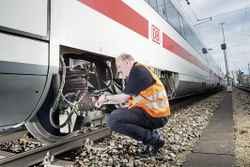
Posted to News on 5th Dec 2016, 15:00
Condition monitoring in plain text and real time
Schaeffler has developed a concept for a condition monitoring system (CMS) with intelligent software and a connection to the Cloud for digital, real-time monitoring of bogies in passenger trains. By evaluating this data, higher average speeds, greater operating performance and longer maintenance intervals can be achieved for future train generations, while also improving operating reliability.

The compact sensor units, which are specifically developed for rail applications, are used to measure structure-borne sound, temperatures and speeds on the axlebox bearings. This enables the detection of damage to axlebox components such as rolling bearing defects or imbalanced wheel rims. In addition, on a motorised bogie frame, the drive motor and gearbox can be monitored using vibration measurements. A processor unit converts the raw measurement data into parameters, which reduces the volume of data that must be transmitted. This data is then analysed automatically, either in the Schaeffler Cloud or in a local entity and displayed as plain text. Unlike a conventional CMS, the customer does not need to possess vibration-specific expertise or skills to perform manual evaluations. The operator or maintenance technician is connected to the Cloud and can monitor the condition of individual axlebox bearings and even entire axleboxes and bogies.
In addition, Schaeffler is also providing a new digital service for real time, load-based calculation of grease service life. Depending on the train operator, train type and region, after around one million kilometres in service, axlebox bearings are removed, inspected, cleaned, greased and re-installed. To date, operational impacts have only been taken into consideration in the maintenance intervals as general safety factors. Now, as a result of Schaeffler's digital service grease service life calculation, for the first time, these safety factors or unused reserves can now be utilised. In combination with other data from the CMS, rail operators can now potentially achieve longer maintenance intervals and better operating performance by closely monitoring the actual loads on the axlebox bearings during operations.
Measurement of bearing temperatures by the combined sensor unit fulfils the requirements of SIL2 standards that are relevant to rail sector operations. This means that the temperature signals can also be used by the CMS to reliably detect and alert operators to a "hot box' condition. The term "hot box' refers to the external heating up of an axlebox bearing. The development of the combined sensor was in line with EN 15437-2 standards on "Performance and design requirements of on-board systems for temperature monitoring'.
For more information about the condition monitoring system, please go to www.schaeffler.co.uk.






























